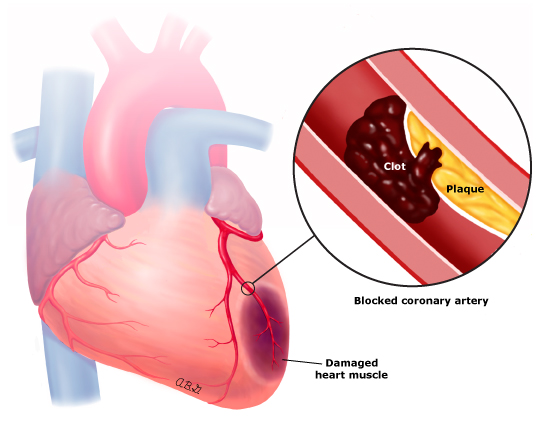Acute myocardial infarction (heart stroke) is a condition in which the heart muscle suffers from lack of blood supply and necrosis due to sudden blockage of the coronary artery (blood vessel that feeds the heart muscle) by a thrombus in the vessel.
If blood flow is not restored quickly, an acute myocardial infarction can cause permanent heart muscle damage and death. In the United States, about 635,000 people have a heart attack and about 300,000 people have a second heart attack each year. One in every seven deaths is due to cardiovascular disease, including myocardial infarction.
1. Causes of acute myocardial infarction
The cause of acute myocardial infarction is due to the atherosclerotic plaque in the coronary artery being cracked or broken, blood cells including platelets and red blood cells attach to it, forming a thrombus that causes sudden blockage of the artery. stop blood supply to the distant myocardium. If this condition persists, it will lead to myocardial necrosis, causing heart failure or sudden death.

The atherosclerotic plaque is ruptured
Risk factors for atherosclerotic plaque rupture:
- Smoke;
- Excessive emotions and stress;
- Excessive exertion;
- Inflammation or infection such as pneumonia, exacerbation of chronic obstructive pulmonary disease, etc.
- After injury, surgery...
2. Warning signs of acute myocardial infarction
When having an acute myocardial infarction, the patient can recognize it through characteristic signs such as:
- Typical angina with symptoms of pain, pressure, and twisting in the chest, behind the sternum or left chest. The pain often appears suddenly, lasts more than 20 minutes, and spreads to the back, neck, chin, shoulders or arms. The pain is accompanied by fatigue, nervousness, difficulty breathing, sweating, panic or fainting, and the pain is not relieved by sucking or spraying nitrate medicine.
- Some special cases such as the elderly, women or diabetic patients may not have symptoms of chest pain, but have equivalent symptoms of difficulty breathing, changes in mental status, fainting or hypotension < 90 /60 mmHg.
Not everyone has the same symptoms. Some people have mild pain, some people have severe pain, and others have the first sign of sudden cardiac arrest.
3. Treatment of acute myocardial infarction
Drug treatment
Patients with acute myocardial infarction use antiplatelet drugs, anticoagulants, and antianginal drugs if angina occurs.
Using Nitroglycerin is one of the basic initial treatments for patients with acute myocardial infarction with prolonged angina, hypertension or acute pulmonary edema.
More information here

Long-term treatment after acute myocardial infarction
Patients after myocardial infarction need long-term treatment and care to avoid recurrence and future complications.
- Functional evaluation
- Lifestyle changes: Exercise regularly, change your diet, lose weight, stop smoking
- Medications: Continue antiplatelet medications, beta blockers, ACE inhibitors, and statins